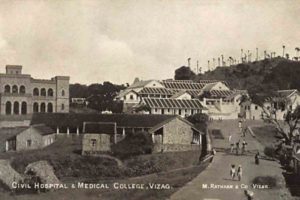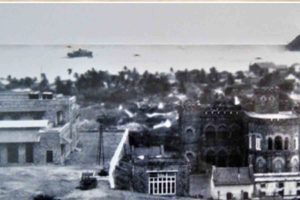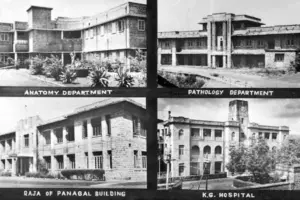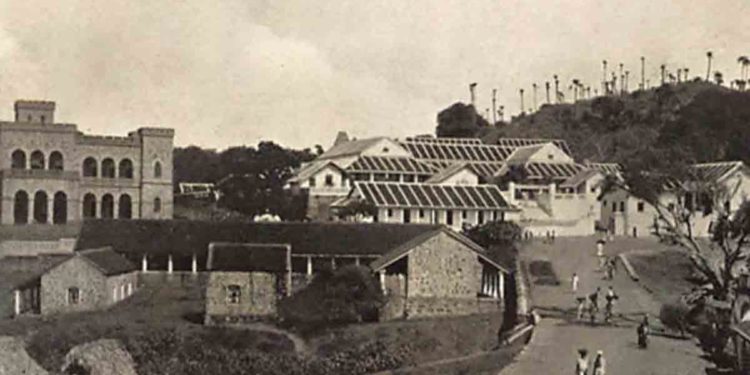The crime of Patriotism at Vizagapatam Medical College: The Andhra Medical College records its history to the 1923 opening of the new buildings adjacent to the King George Hospital, but little is known of its predecessor institutions and the forgotten medical student Freedom Fighters of the 1920s.
The Victoria Diamond Jubilee Medical School started in 1902 with 10 students near the present Queen Mary’s High School at the old Vizag post office and was supported by the Goday family’s Maharajah Sir Goday Narayana Gajapathi Rao. Maharani Lady Chittijanakiammah Gajapathi Rao honoured her late husband’s wishes and provided the land and building for a new college in Waltair. About 1912, the school was transferred and the building was commissioned as the Vizagapatam Medical College and started operations with 32 students. The brightest students from Vizag were able to study for the MBBS or Licentiate LMS. Later, the Government planned for a new hospital and built the adjacent Andhra Medical College which was opened informally on 7 July 1923, by Captain Frederick Jasper Anderson, Indian Medical Service, officiating as Principal who was also the professor of anatomy and surgery. The formal opening was on 19 July 1923, by the Hon Diwan Bahadur Rajah Panuganti Ramarayaningar, MA, Minister for Local Self Government Department, the then Chief Minister of Madras, and Minister for Health.

Vizag’s Civil Hospital was started as a civil dispensary in 1845 and upgraded to a 30-bed hospital in 1857. The Rajah of Vizianagram endowed it and the Sisters of St Joseph from the Convent in Waltair provided the nursing care. AV Jagga Rao erected a dispensary and public benefactors progressively build cottages around it. The Government added a septic room, an operating theatre, and a maternity ward. The Civil Hospital was replaced by a new building, which was named King George Hospital and inaugurated by Hon Rajah of Panagal, Chief Minister of Madras on 19 July 1923.

Vizagapatam Medical College c 1920 Courtesy: Dr Prof Rednam Ahi Krishna, Retired Principal of Andhra Medical College
Vizagapatam Medical College’s academic staff was accomplished English doctors from the Indian Medical Service. The college was run along with English norms with the young students expected to dress in suit & boot like pukka sahibs. This aspect of their medical training was to put the students in the headlines during the freedom struggle. On the 28th of September 1921, 142 medical students at the Vizagapatam Medical College entered their classes wearing white Gandhi Khadi caps. The administrators were furious, and the students pointed to the accepted dress practice of local court staff and countered the objection to white caps by dyeing their caps black. An infuriated administration demanded an apology that led to 32 students refusing to do so and they were dismissed from the college.

Mahatma Gandhi commended the medical students as examples to individuals in other walks of life that could stake lifestyle and career for a higher moral cause. He said…’ the country is suffering from the chronic disease of bondage. Those who spend themselves in finding and applying the true remedy for the disease become true surgeons and physicians, and when that universal disease is cured, most of the other diseases like the plague, cholera, malaria etc. will disappear, and the country will be better prepared to train medical men and women in order to treat them… Some Vizag lawyers, teachers, Government workers took up the message of self-sacrifice and brave suffering for self-respect as 6 students also left Mrs AVN College and CBM High School in Vizag.
In the Collected Works of Mahatma Gandhi, he wrote … What is the crusade against the students of the Vizagapatam Medical College if not an insensate crusade against the khadi? He also wrote ‘More about Medical Students’…
I am able this week to publish the correspondence referring to the Vizagapatam medical students. It is long but both interesting and instructive. It shows the mentality of the medical authorities and also of the Government. The final orders dismissing the students were passed under advice or with the cognizance of the Government of Madras; The reader will note that the dress regulations were not strictly carried out at all and that after the caps were coloured black there was no excuse whatsoever for banning them. But the fact that the students had the audacity to wear khadi was enough to rouse the ire of the college authorities. The reader will also note the humiliating character of the dress regulations. The tuft of hair or a baldhead, a mark both of religion and respectability, must be hidden because it offended the Western taste of the Western professors. They could not enter the college with Indian shoes on. They must wear English shoes or remain barefoot. Thus the students are taught at an impressionable period of their lives to discard national dress. As a matter of fact Indian shoes for the Indian climate are infinitely superior to the English shoes as being airy and therefore more hygienic. The introduction of socks is inelegant and totally useless for the hot climate of India. Socks-wearers know the stench that their socks emit in this climate…Young India, 24-11-1921
The issue of khadi cap wearing students touched off a furor in other parts of India. The Bombay Court took issue with any headdress other than a turban, the folk of Gujarat contended that it was inoffensive everyday wear, and in some courts, peons and court staff had always worn black khadi caps.
Little did we know that Vizag medical students of 1921 were guilty of the Crime of Patriotism by establishing that ‘Khadi was Kool’ during the freedom movement in India.
Written by John Castellas whose family belonged to Vizag for 5 generations. Educated at St Aloysius, migrated to Melbourne, Australia in 1966, former General Manager Engineering at Boeing & Qantas Airways, in retirement Lecturers in Aviation Management at Swinburne University and is a Vizag aficionado.










Discussion about this post